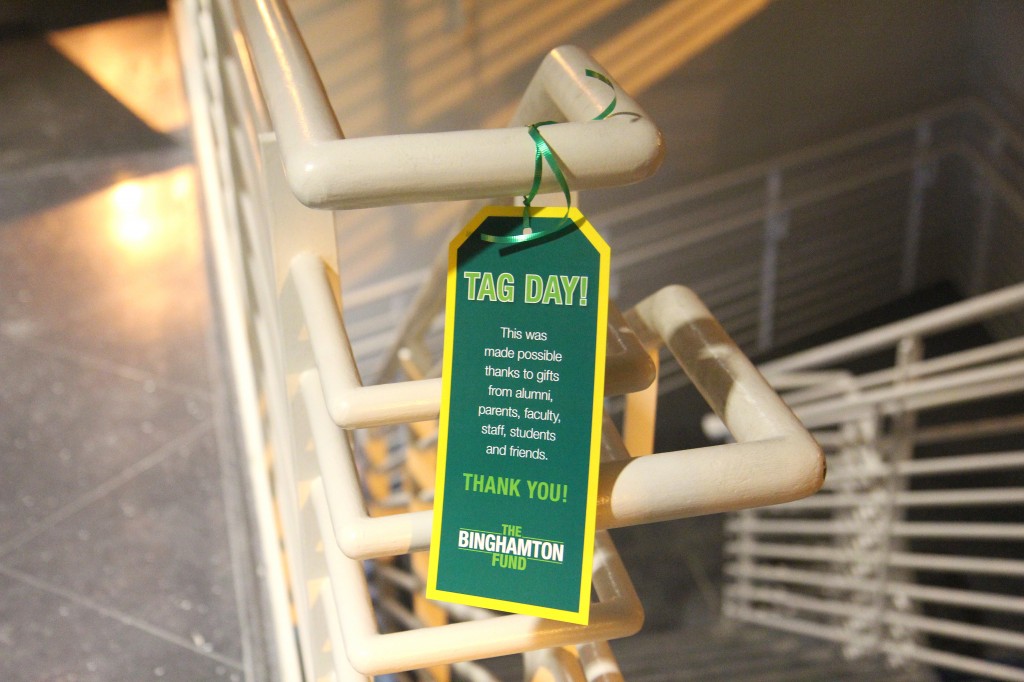
In an effort to highlight the importance donations have in developing Binghamton University’s campus, several University groups organized Tag Day.
Tag Day, which took place Thursday, was organized by the Student Philanthropy Committee, the Binghamton Fund, the Alumni Association and Student Affairs. Organizers placed more than 500 “tags” around campus, denoting objects that were donated to BU or purchased using donated funds.
According to Caitlyn Carlson, director of the Binghamton Fund, the goal of Tag Day was to educate students, faculty and staff on the effects donations have at BU.
“It provides a visible representation of all the areas of campus that benefit from donor support,” Carlson wrote in an email.
BU’s first Tag Day coincided with similar events at nearly 100 other schools worldwide, according to Carlson. The event was designed to point out the everyday facets of campus life that exist only because of donations.
“The idea originally came about because donors provide crucial resources to the entire campus, but it’s not always immediately obvious,” Carlson wrote. “For example, do people on campus know that the new Graphic Design lab in rooms 343 and 347 in the Fine Arts building was made possible through multiple gifts made to the Binghamton Fund for Harpur College account?”
Andrew Loso, co-chair of the Student Philanthropy Committee and a junior double-majoring in history and Spanish, commended the people who donated to BU and said it’s important to highlight their contribution.
“It’s not surprising,” Loso said. “Our donors are often anonymous or just really humble people, so there’s no one to blame for not understanding how their gifts help the University.”
Tags were placed on objects purchased through monetary donations, but also on objects donated directly to the University.
“The tags denote both dollar gifts (restricted, unrestricted, endowments, etc.) and gifts in kind,” Carlson wrote. “Some examples of gifts in kind include artwork in the University Art Museum, a wheelchair that’s in the Decker School of Nursing Dean’s Suite, books in the library.”
Organizers collaborated with Residential Life, leaders in the Union, Athletics, the Anderson Center, University Art Museum and each of the schools to determine where to place tags.
“We discussed things like what are some of the more highly visible parts of campus where students, faculty, and staff will see these items as well as if there are gifts in kind, such as art work, library books and equipment that can be tagged,” Carlson wrote.
According to the Foundation, BU received $13,576,134 in donations in the 2013 fiscal year, amounting to $8.9 million after expenditures. Of the $13,576,134, $6,458,190 in donations consisted of gifts in kind.
Carlson said that donations made to BU are necessary to make up for where state funding lacks. For example, Carlson said state funding pays for the cost of construction, but it would not cover furnishings needed for the building.
“Gifts from our donors have a huge impact on the University,” Carlson wrote. “There’s a gap between what state funding and tuition covers – and what helps makes up that gap is private support from generous donors, whether it’s through the Binghamton Fund, which is the annual giving program, larger endowments or gifts in-kind.”
BU has an amazing alumni network that chooses to pay it forward so that students today can have a premier university experience. But donors also make up parents, community members and increasingly, students who are currently on campus. Without the participation of many, many individuals who give gifts of all sizes, BU wouldn’t be what it is today.


